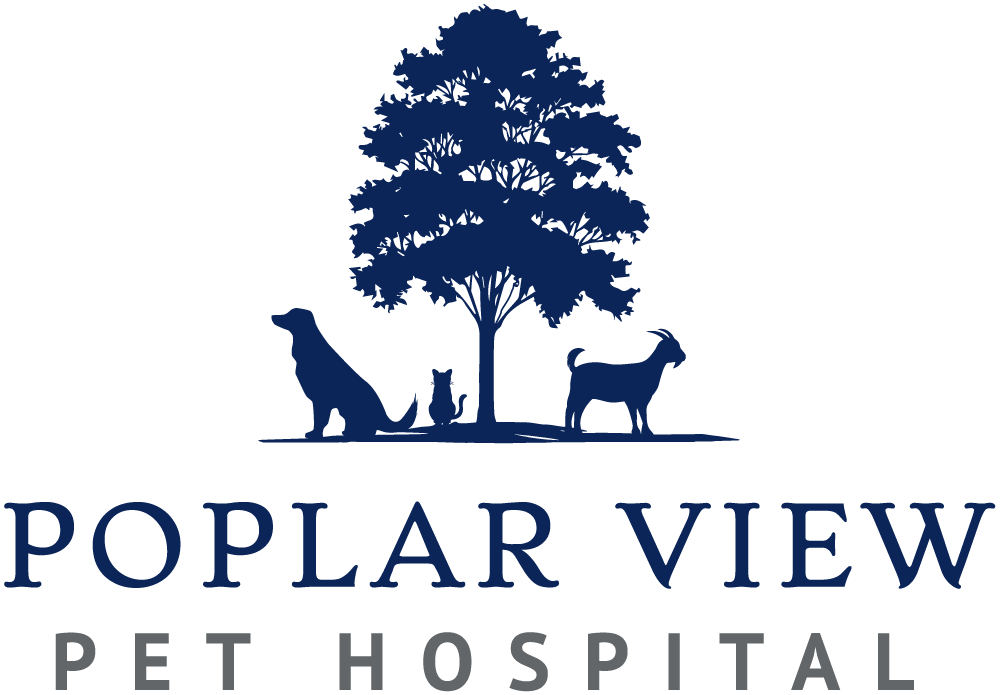Watching your furry friend recover from dog surgery can be emotionally challenging. Your dog may seem confused, uncomfortable, or just not themselves after their procedure.
Recovery takes time and patience, but with the right approach, you can help lift your dog’s spirits and support their healing journey. If you’re preparing for your pet’s upcoming procedure, schedule a dog surgery at Poplar View Pet Hospital for compassionate, expert care.
Why Dogs Feel Down After Surgery
Effects of General Anesthetics on Mood and Behavior
General anesthetic affects your dog’s entire nervous system, not just their physical sensations. The medications used during dog surgery can leave your pet feeling disoriented and groggy for 24-48 hours after the procedure. These drugs alter brain chemistry temporarily, which can cause mood changes, anxiety, or depression-like symptoms. This emotional flatness is completely normal and typically improves as the medication leaves their system.
Physical Discomfort and Confusion
Post-surgery pain creates both physical and emotional stress for your dog. Even with pain medication, your pet may experience soreness, stiffness, or throbbing at the surgery site. This discomfort can make them reluctant to move, eat, or engage in normal activities. Additionally, dogs don’t understand why they feel different or why they’re wearing a plastic cone or bandages. This confusion adds to their emotional distress and can manifest as whimpering, restlessness, or seeming “sad.”
Disruption to Routine and Environment
Dogs thrive on routine, and surgery disrupts everything familiar in their daily life. They’ve spent time in an unfamiliar veterinary hospital, surrounded by strange smells and sounds. Activity restrictions prevent them from enjoying their usual walks, playtime, or favorite sleeping spots. These changes can trigger anxiety and depression, especially in dogs who are particularly attached to their routines. Recovery from dog surgery forces them to adapt to temporary new normals, which can be emotionally taxing.
7 Common Things to Expect After Dog Surgery
- Grogginess and disorientation – Your dog will likely be unsteady on their feet and may seem “drunk” for the first 12-24 hours as the anesthetic wears off.
- Decreased appetite – It’s normal for dogs to refuse food or eat less than usual for 1-2 days after surgery.
- Increased sleeping – Expect your pet to sleep much more than normal as their body focuses energy on healing.
- Mild whimpering or vocalization – Some dogs express discomfort through quiet whining, especially when changing positions.
- Reluctance to move – Your dog may resist getting up for bathroom breaks or seem hesitant to walk.
- Swelling at the incision site – Mild swelling and bruising around the surgical area are expected for the first few days.
- Changes in bathroom habits – Anesthesia and pain medications can cause temporary constipation or changes in urination frequency.
How long does it take to recover after dog surgery?
Most dogs show significant improvement within 7-10 days after surgery. However, complete healing can take several weeks to months, depending on the procedure. Simple veterinary surgeries like spay/neuter typically require 10-14 days for incision healing, while orthopedic surgeries may need 8-12 weeks for full recovery. Your veterinarian will provide specific timelines based on your dog’s procedure and individual healing progress.
6 Factors That Affect Recovery Time
- Type of dog surgery performed – Minor procedures heal faster than major operations involving bones or internal organs.
- Your dog’s age – Younger dogs typically recover more quickly than senior pets due to better circulation and cell regeneration.
- Overall health status – Dogs with chronic conditions or weakened immune systems may need extra recovery time.
- Size and breed – Larger breeds often take longer to heal from orthopedic surgeries due to increased weight on healing bones.
- Post-operative care compliance – Following your vet’s instructions precisely can significantly speed up healing time.
- Nutrition and hydration – Well-nourished dogs with adequate water intake tend to heal faster than those with poor appetites.
6 Things Your Dog Needs After Surgery
Emotional Support and Bonding
Your presence and gentle attention provide immense comfort to your recovering dog. Spending quiet time together, offering soft words of encouragement, and maintaining calm energy helps reduce their anxiety. Physical touch, when appropriate for their condition, releases endorphins that naturally improve mood and promote healing. Remember that your dog picks up on your emotions, so staying positive and relaxed will help them feel more secure during recovery.
The Perfect Recovery Environment
A well-designed recovery space significantly influences your dog’s emotional state and healing speed. Dogs recovering in calm, comfortable environments experience less stress, which allows their bodies to focus energy on healing rather than anxiety. The right setup minimizes complications, prevents injury from excessive movement, and provides the security your pet needs to rest properly.
How to Create the Perfect Dog Surgery Recovery Environment
- Choose a quiet room away from household traffic
- Set up comfortable bedding on the floor
- Ensure proper room temperature
- Position food and water within easy reach
- Remove hazards and obstacles
- Add familiar comfort items like toys or blankets
- Prevent access to stairs or other dangerous areas
Pain Management and Comfort Measures
Dogs are masters at hiding pain, making it crucial to watch for subtle signs of discomfort after surgery. Look for changes in breathing patterns, reluctance to move, excessive licking at the incision site, or unusual postures. Even with prescribed pain medication, your dog may experience breakthrough pain, especially during the first 48-72 hours post-surgery.
6 Ways to Manage Pain After Dog Surgery
- Administer pain relievers exactly as prescribed – Never skip doses or adjust timing without veterinary surgeon approval, as consistent levels prevent pain spikes.
- Apply cold compresses to reduce swelling – Use ice packs wrapped in towels for 10-15 minutes at a time during the first 24-48 hours.
- Try a gentle massage away from the surgery site – Light touch on non-affected areas can release natural pain-relieving endorphins.
- Monitor and document pain levels – Keep a log of your dog’s comfort to share with your vet for medication adjustments.
Gentle Activities and Mental Stimulation
Mental stimulation during recovery prevents boredom and depression while respecting physical limitations after dog surgery. Gentle activities like puzzle games keep your pet’s mind engaged without risking injury to healing tissues. These exercises maintain the human-animal bond, provide positive distraction from discomfort, and can actually speed healing by reducing stress hormones. The key is finding activities that challenge the mind while keeping the body relatively still.
6 Games and Exercises You Can Do After Dog Surgery
- Hide treats in a muffin tin – Cover treats with tennis balls to create a simple puzzle that exercises their nose and brain.
- Practice basic obedience from a lying position – Work on “stay,” “watch me,” or “touch” commands while your dog rests comfortably.
- Use snuffle mats or lick mats – These puzzle toys provide 15-20 minutes of calm, focused activity without physical exertion.
- Play gentle “find it” games – Hide treats in easy-to-reach spots around their recovery area for nose work stimulation.
- Read or talk to your dog – Your voice provides comfort and mental engagement without any physical activity required.
- Short, controlled walks – If approved by your veterinary surgeon, very brief outdoor sessions for bathroom needs can provide mental enrichment.
Nutrition and Appetite Support
Proper nutrition accelerates healing after dog surgery, but many pets experience decreased appetite due to anesthesia effects and discomfort. The medications used during dog surgery can cause nausea that lingers for days, making formerly favorite foods unappealing. Creating an enticing meal plan that’s easy to digest helps ensure your dog gets the nutrients needed for tissue repair.
What Foods Help a Dog Heal After Surgery
- Bone broth – Provides hydration, minerals, and collagen to support tissue healing while being gentle on the stomach.
- Lean boiled chicken – An easy-to-digest protein source that most dogs find appealing, even with reduced appetite.
- Pumpkin puree – Helps regulate digestion and provides fiber to combat post-surgery constipation from pain medications.
- White rice – Bland carbohydrate that provides energy without upsetting sensitive stomachs.
- Omega-3 supplements – Fish oil reduces inflammation and supports immune function during healing.
When Should You Take Your Pet Back to the Vet
While some discomfort is expected after dog surgery, certain symptoms require immediate veterinary attention. Contact your vet if your dog shows no improvement after 48-72 hours, or if their condition worsens at any point. Trust your instincts. You know your pet best, and it’s always better to err on the side of caution when recovery doesn’t seem to progress as expected.
8 Signs of Complications After Dog Surgery
- Excessive bleeding or discharge from the incision
- An opening in the incision or visible tissue
- Extreme lethargy or unresponsiveness
- Persistent vomiting or diarrhea
- Difficulty breathing or pale gums
- Fever above 103°F
- Complete refusal to eat or drink for over 24 hours
- Severe pain despite medication
Conclusion
Helping your furry friend recover emotionally after dog surgery requires patience, observation, and lots of love. By creating a comfortable environment, managing pain effectively, and providing appropriate mental stimulation, you’ll support both physical healing and emotional well-being.
Remember that every dog recovers at their own pace, and temporary mood changes are completely normal. For expert dog surgery care and comprehensive recovery support, schedule an appointment with us at Poplar View Pet Hospital. Follow us on Facebook and Instagram for more pet care tips and updates.

